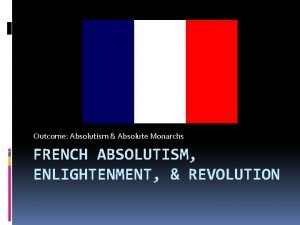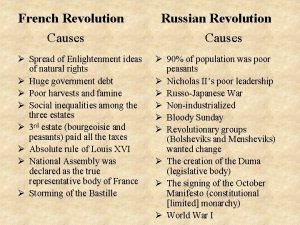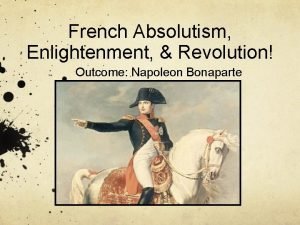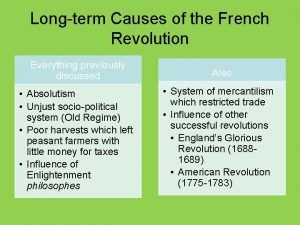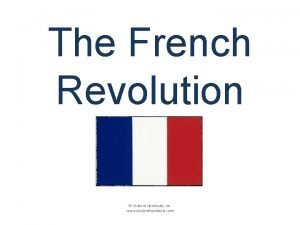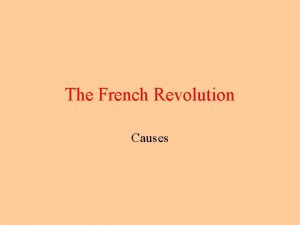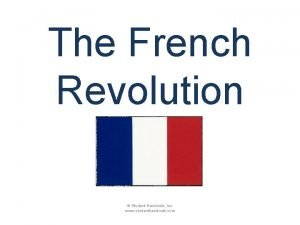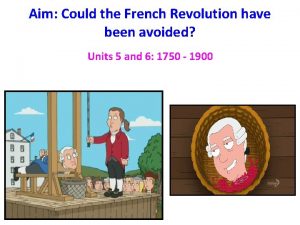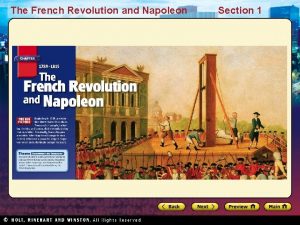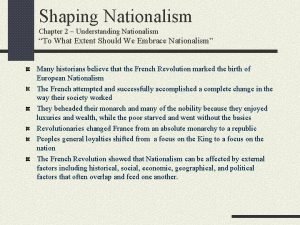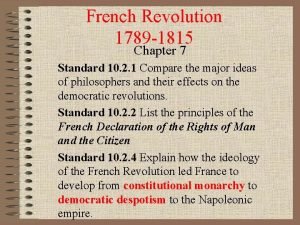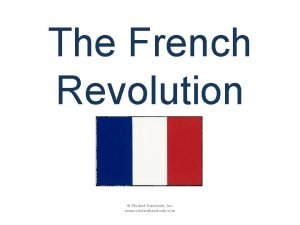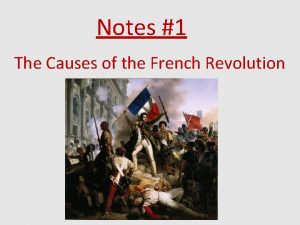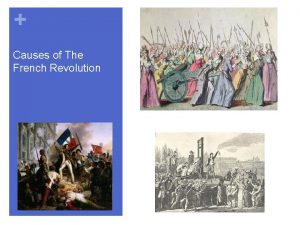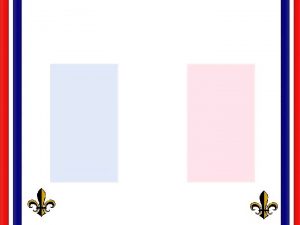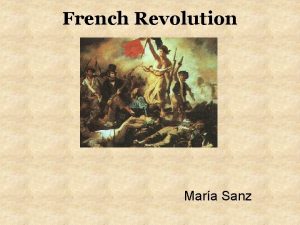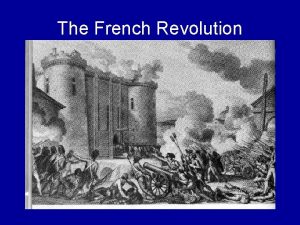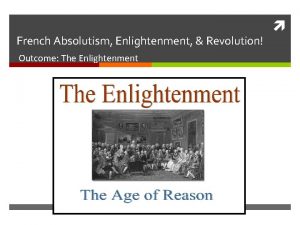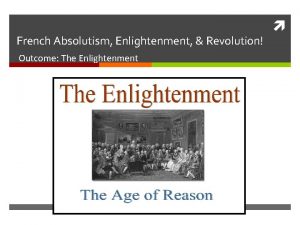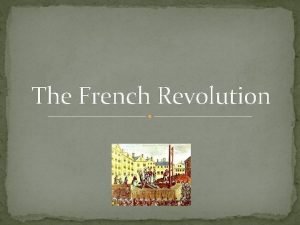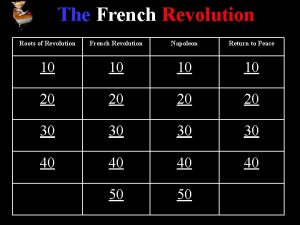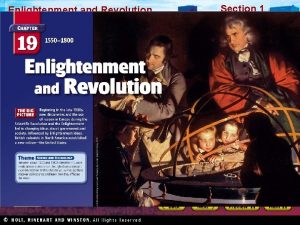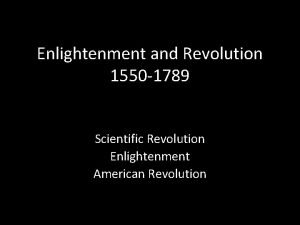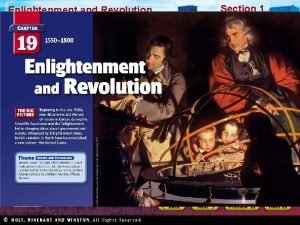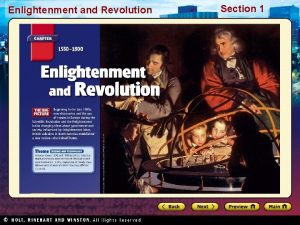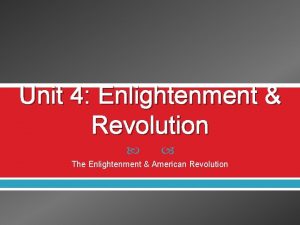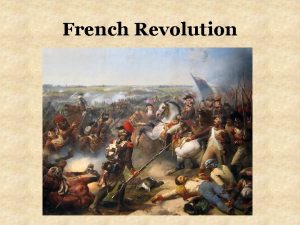The French Revolution Causes of the Revolution Enlightenment




























- Slides: 28

The French Revolution

Causes of the Revolution • Enlightenment ideals • Money troubles (debt) • Bad harvests • Class conflicts of the Ancien Regime

Ancien Regime

Causes of the Revolution The Enlightenment: • An intellectual movement based on reason and logic that was applied to human nature • Hobbes, Locke, Montesquieu, Rousseau, Voltaire

Causes of the Revolution Money troubles/Debt: • French spent most of its money on war (especially the French and Indian War and the American Revolution and excesses such as the Palace of Versaillies.

Causes of the Revolution Bad harvest/drought: • Less food leads to larger demand which makes prices increase. • Very high bread prices • King doesn’t help!

Causes of the Revolution Ancien Regime: • The political and social system of France prior to the French Revolution • Under the regime, everyone was a subject of the king of France as well as a member of an estate and province. All rights and status flowed from the social institutions, divided into three orders (estates)

• 0. 5% of the population • Does not pay taxes Clergy • 1. 5% of the population • Does not pay taxes • 98% of the population • Pays taxes Nobility First Estate Bourgeoisie (middle class, merchants, etc. ) and peasants

Meeting of the Estates General • Summoned May 5, 1789 • King Louis XVI calls a meeting of the estates general • First time in 175 years. Why? • Met to solve France’s economic problems st nd rd • 1 & 2 Estates gang up on 3 Estate. Why?

Meeting of the Estates General Second Estate First Estate Third Estate

National Assembly & the Tennis Court Oath • June 17, 1789 • Fights break out over the number of votes each Estate gets • Third Estate breaks off and renames themselves the National Assembly • National Assembly gets locked out of meeting so they go to the tennis court and won’t come out until they get what they want: a constitution. This is called the Tennis Court Oath.

Tennis Court Oath

Results of the Tennis Court Oath • Storming of the Bastille • Declaration of the Rights of Man and of the Citizen • Women’s March on Versailles

Results of the Tennis Court Oath Storming of the Bastille • July 14, 1789 • Medieval fortress and prison • People heard Louis XVI was sending out his military to keep order • Had a cache of weapons • Symbol of the French Revolution


Results of the Tennis Court Oath Declaration of the Rights of Man and of the Citizen • Issued Aug. 26, 1789 • A document that guaranteed due process in judicial matters and established sovereignty among the French people. • Effectively ended the ancien régime

Liberté, Égalité, Fraternité

Results of the Tennis Court Oath Women’s March on Versailles • Oct. 5, 1789 • An angry mob of nearly 7, 000 working women armed with pitchforks, pikes, and muskets marched in the rain from Paris to Versailles to demand bread. • Became focused on Marie Antoinette, “Let them eat cake. ” • Women demanded royal family hand out the bread in the palace and then go to Paris to see the plight of the people. • The royal family goes to Paris and are imprisoned until their execution in 1791.


Louis XVI and Marie Antoinette

The National Assembly Made up of 3 groups 1. Jacobins 2. Girondins 3. Royalists

The National Assembly Jacobins • A group of radical liberals • Wanted to drive the Revolution forward aggressively • In favor of executing the king • Sat on the left side of the Assembly (today anyone who is a liberal is considered “to the left”) • Led by Maximilien Robespierre

The National Assembly Girondins • A group of moderate revolutionaries • Wanted a constitutional monarchy • Thought the king had the right to a trial • Did not want to execute the king

The National Assembly Royalists (Monarchists) • Conservatives (don’t like change) who supported the king • Would have an absolute monarch or a constitutional monarch • Sat on the right side of the Assembly (today anyone who is a conservative is considered “to the right”)


Reign of Terror • Started with the death of Louis XVI • Led by the Committee of Public Safety • Mission: to kill anyone against the Revolution • Led by Robespierre • Killed 16, 000 people (some reports say up to 40, 000) • Ended when Robespierre got out of control and was executed

Reign of Terror – Death of Louis XVI “The National Razor”

National Convention • The era after Robespierre’s downfall • Constitution of 1795 – made up a new type of government • The new legislature would consist of two houses and an executive body: 1. Upper house – made up of 250 members 2. Lower house (called the Council of Five Hundred) – made up of 500 members. 3. Directory – made up of 5 officers
 Absolutism definition french revolution
Absolutism definition french revolution Enlightenment and french revolution
Enlightenment and french revolution French absolutism enlightenment & revolution
French absolutism enlightenment & revolution French absolutism enlightenment & revolution
French absolutism enlightenment & revolution French absolutism enlightenment & revolution
French absolutism enlightenment & revolution The french revolution political causes
The french revolution political causes American revolution causes and effects
American revolution causes and effects French revolution causes and effects
French revolution causes and effects French revolution causes and effects
French revolution causes and effects France story
France story Short term causes french revolution
Short term causes french revolution The causes of the french revolution
The causes of the french revolution French revolution causes
French revolution causes Old regime french revolution
Old regime french revolution French revolution causes
French revolution causes Short term causes of the french revolution
Short term causes of the french revolution Could the french revolution have been avoided
Could the french revolution have been avoided Causes and effects of french revolution
Causes and effects of french revolution Social causes of french revolution
Social causes of french revolution Causes and effects of the french revolution
Causes and effects of the french revolution French revolution
French revolution Immediate cause of french revolution
Immediate cause of french revolution You should hope that this game will be over soon
You should hope that this game will be over soon Storming of the bastille cartoon
Storming of the bastille cartoon Cause of the french revolution
Cause of the french revolution Explain the causes of french revolution
Explain the causes of french revolution The causes of the french revolution
The causes of the french revolution Russian revolution vs french revolution
Russian revolution vs french revolution Hobbes and locke venn diagram
Hobbes and locke venn diagram
